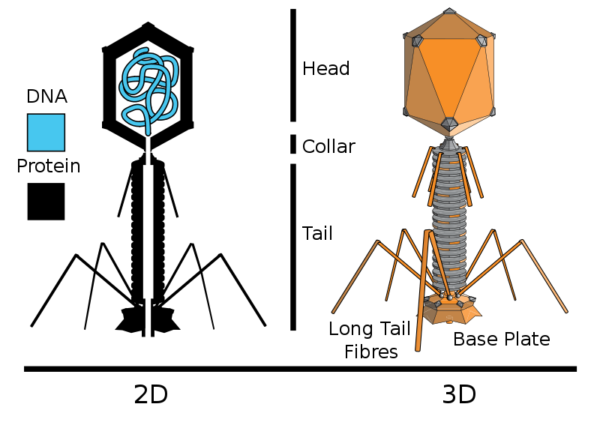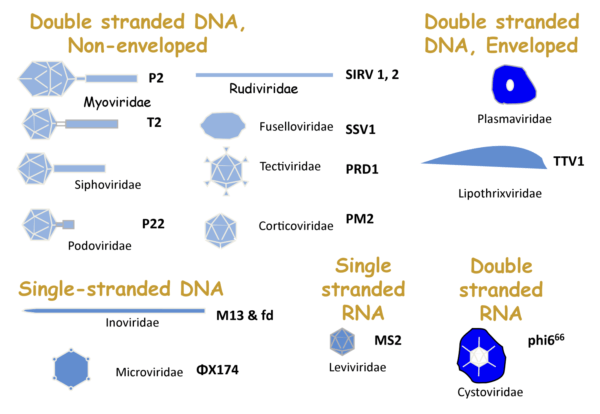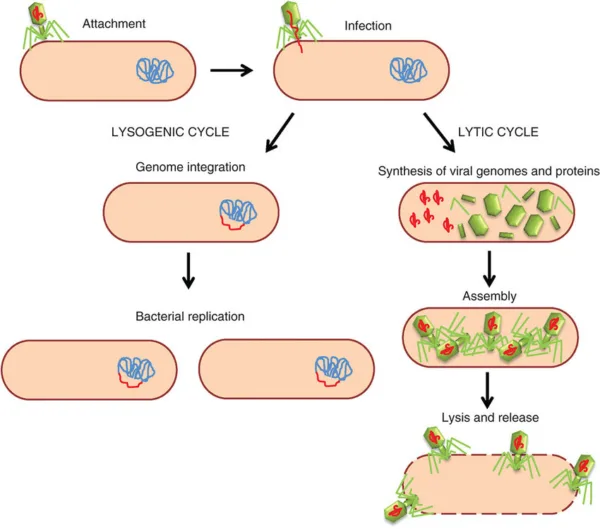What are Bacteriophages?
Bacteriophage, or phages, are viruses that specifically target bacteria, leading to the death and lysis of infected cells. Phages are characterized by their small size and dependence on parasitism. A phage consists of a protein capsid that encloses a single type of nucleic acid (DNA or RNA) for genetic protection. Most phages also possess a protein tail, allowing them to attach specifically to receptors on the surface of host bacteria. The phage lytic cycle begins with the injection of genetic material into the cell, followed by the takeover of bacterial machinery for genome replication and protein synthesis.
Structural proteins are assembled, and the phage genome is encapsulated within the capsid, resulting in the formation of mature viral particles. Upon cell lysis, numerous phages (typically 50 to 100) are released, ready to infect other targeted cells. Phages are incredibly abundant, outnumbering bacteria by an estimated 10-fold, and are found wherever their bacterial hosts exist. Their specificity, long-term survival, and rapid replication in suitable hosts contribute to their crucial role in maintaining ecological balance among various bacterial species in natural ecosystems.
Structure of Bacteriophage
Bacteriophages, also known as phages, are fascinating viruses that have evolved to infect and manipulate bacterial cells. Understanding their structure is key to unraveling their intricate mechanisms of infection and their potential applications in various fields. In this article, we explore the structure of bacteriophages in detail, shedding light on their diverse components and their functional significance.

1. The Head or Capsid:
At the core of a bacteriophage lies its head or capsid, a proteinaceous shell that encapsulates the genetic material of the virus. The size and shape of the head can vary among different phages. Some phages possess an icosahedral structure with 20 sides, while others are filamentous in shape. The capsid is composed of numerous copies of specific proteins, forming a protective covering for the phage’s genetic material.
2. Nucleic Acid:
Within the head, the bacteriophage harbors its nucleic acid, which can be either DNA or RNA. The genetic material carries the essential instructions for the replication and assembly of new phage particles. The type and arrangement of nucleic acid may differ among various phages, contributing to their specific characteristics and modes of infection.
3. Tail and Tail Fibers:
Many bacteriophages possess a tail structure, extending from the head. The tail is a hollow tube through which the viral nucleic acid passes during the infection process. The size and complexity of the tail can vary, and some phages lack a tail altogether. More complex phages, like the T4 phage, have a contractile sheath surrounding the tail, which aids in the penetration of the bacterial cell.
At the distal end of the tail, advanced phages possess a base plate with tail fibers. These tail fibers play a crucial role in recognizing and binding to specific receptors on the surface of the target bacterial cell. However, it is important to note that not all phages have tail fibers, and alternative structures are involved in the binding process in those cases.
4. Enzymes:
Bacteriophages often carry specialized enzymes within their structure, such as lysozymes and endolysins. These enzymes assist in various stages of the infection cycle, including the degradation of bacterial cell walls and the release of newly formed phage particles.
Classification of Bacteriophages
Bacteriophage families can also be classified based on the type of nucleic acid they contain. The two primary types of nucleic acids found in bacteriophages are DNA (deoxyribonucleic acid) and RNA (ribonucleic acid). Here are some bacteriophage families categorized based on their nucleic acids:

1. Caudovirales:
The Caudovirales order is the most extensively studied group of bacteriophages and includes three families: Myoviridae, Siphoviridae, and Podoviridae. These families contain bacteriophages with double-stranded DNA genomes.
2. Microviridae:
The Microviridae family consists of bacteriophages with small, single-stranded DNA genomes. They are non-enveloped and have icosahedral capsids. Phage PhiX174, a well-known member of this family, infects Escherichia coli.
3. Leviviridae:
The Leviviridae family comprises bacteriophages with single-stranded RNA genomes. These phages are non-enveloped and possess icosahedral capsids. Bacteriophage MS2, which infects E. coli, is a notable member of this family.
4. Inoviridae:
The Inoviridae family includes bacteriophages with filamentous capsids and single-stranded DNA genomes. These phages infect a variety of bacteria and exhibit a unique elongated structure. Bacteriophage M13 is a well-studied member of this family.
5. Tectiviridae:
The Tectiviridae family comprises bacteriophages with double-stranded DNA genomes that are enclosed within a lipid envelope. These phages have an icosahedral capsid and infect Gram-positive bacteria. Phage PRD1 is a notable member of this family.
These are just a few examples of bacteriophage families classified based on their nucleic acids. Each family exhibits distinct characteristics and plays a unique role in bacteriophage diversity and biology.
Bacteriophage Replication
Bacteriophage replication refers to the process by which bacteriophages, viruses that infect bacteria, reproduce and generate new viral progeny. Bacteriophages can replicate using two primary mechanisms: the lytic cycle and the lysogenic cycle.
Lytic Cycle:
The lytic cycle is a well-defined and rapid process that results in the destruction (lysis) of the host bacterial cell. The steps involved in the lytic cycle are as follows:
- Attachment: The bacteriophage attaches to specific receptors on the surface of the host bacterium.
- Penetration: The phage injects its genetic material, which can be DNA or RNA, into the host cell.
- Biosynthesis: The viral genetic material takes control of the host’s cellular machinery, redirecting it to produce viral components. The host’s resources are used to replicate the phage’s genetic material and synthesize viral proteins.
- Assembly: The newly synthesized viral components are assembled to form complete phage particles.
- Lysis: The host bacterial cell is lysed, or ruptured, by the action of viral enzymes, releasing the newly formed phages into the surrounding environment.
- Release: The progeny phages can then infect other susceptible bacterial cells and continue the lytic cycle.

Lysogenic Cycle:
In the lysogenic cycle, the bacteriophage integrates its genetic material into the host bacterium’s chromosome, establishing a stable and long-term relationship without causing immediate lysis. The key steps involved in the lysogenic cycle are as follows:
- Attachment and Penetration: The bacteriophage attaches to the host bacterium and injects its genetic material into the cell.
- Integration: The phage DNA integrates into the host bacterium’s chromosome, becoming a part of the bacterial genome. The integrated viral DNA is known as a prophage.
- Replication: As the host bacterium divides and replicates its own DNA, the integrated prophage is also replicated and passed on to the daughter cells.
- Dormancy: The prophage remains latent within the bacterial chromosome, not actively producing new phage particles or causing cell lysis.
- Induction: Certain environmental triggers, such as stress or environmental changes, can activate the prophage to enter the lytic cycle.
- Excision: The prophage is excised from the bacterial chromosome, initiating the lytic cycle and proceeding with the steps of biosynthesis, assembly, lysis, and release.
Both the lytic and lysogenic cycles play significant roles in bacteriophage replication and survival. The choice between these two cycles depends on the specific bacteriophage and the environmental conditions it encounters.
Applications of Bacteriophage
Bacteriophages have several applications across different fields. Here are some notable applications of bacteriophages:
Phage Therapy:
Bacteriophages can be used to treat bacterial infections in humans, animals, and plants. Phage therapy involves the use of specific bacteriophages to target and kill pathogenic bacteria while sparing beneficial bacteria. It has the potential to be an alternative to antibiotics, especially in cases of antibiotic-resistant infections.
Food Safety:
Bacteriophages can be used as biocontrol agents to improve food safety. They can target and kill bacteria that cause foodborne illnesses, such as Salmonella, E. coli, and Listeria. Phage-based products can be applied to food surfaces or used during food processing to reduce bacterial contamination.
Agriculture and Aquaculture:
Bacteriophages can be employed in agriculture and aquaculture to combat bacterial diseases in crops, livestock, and fish. By specifically targeting bacterial pathogens, they can help control and reduce the use of antibiotics in these industries.
Diagnostic Tools:
Bacteriophages can be used in diagnostic tests to detect the presence of specific bacteria. Phage-based assays can provide rapid and specific identification of bacterial pathogens, aiding in the diagnosis of infections.
Biofilm Disruption:
Bacterial biofilms can be challenging to eliminate with traditional antimicrobial agents. Bacteriophages can target and disrupt biofilms, making them useful in various settings, including medical devices, industrial equipment, and water treatment systems.
Biotechnology and Research:
Bacteriophages have been widely used in molecular biology research as tools for genetic engineering and gene delivery. They can be utilized to introduce specific genes into bacterial hosts or serve as vectors for recombinant DNA technology.
Environmental Applications:
Bacteriophages play a crucial role in the ecological balance of microbial communities in natural environments. They can influence the abundance and composition of bacterial populations, which has implications for wastewater treatment, bioremediation of pollutants, and ecological studies.
Learn more